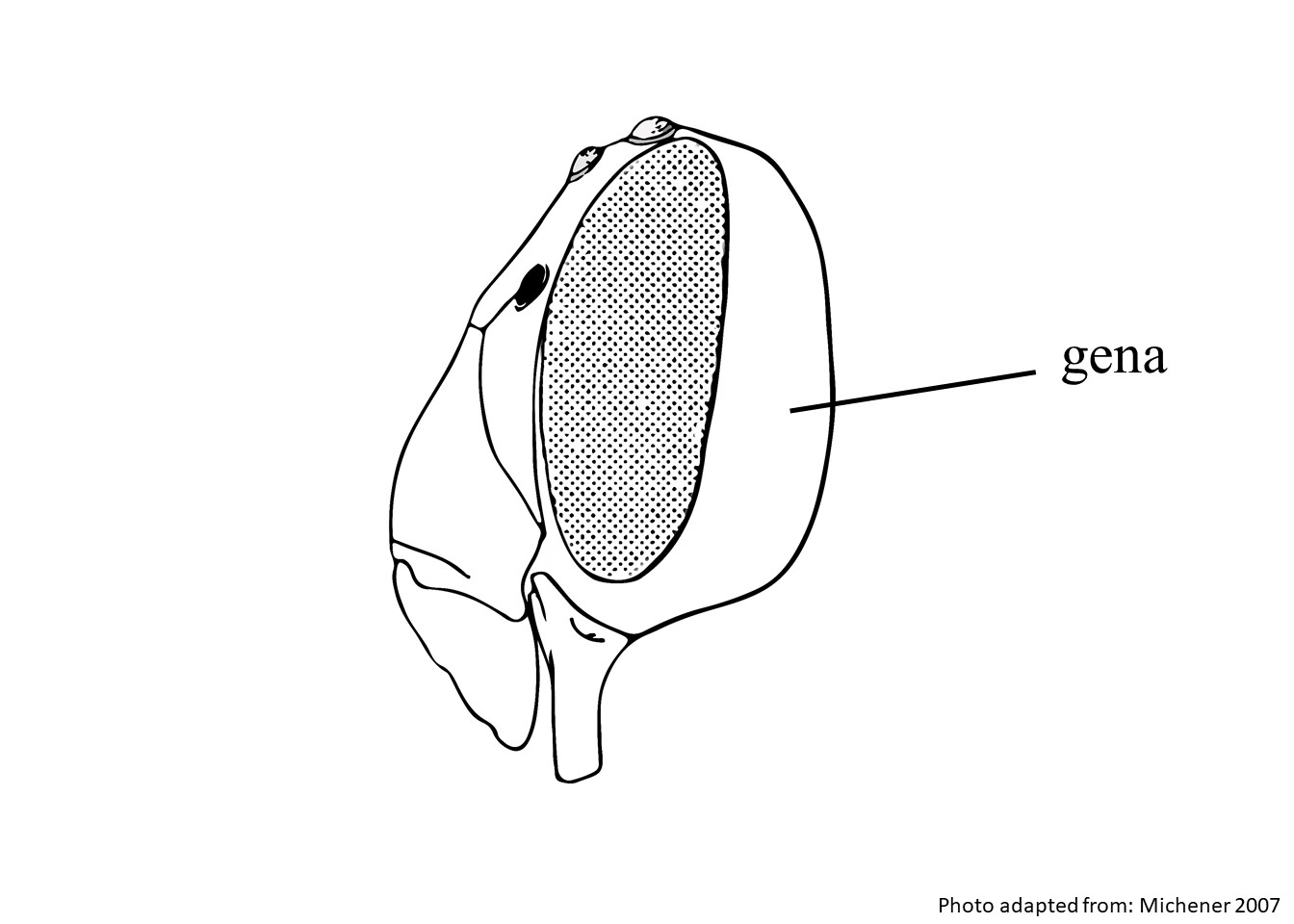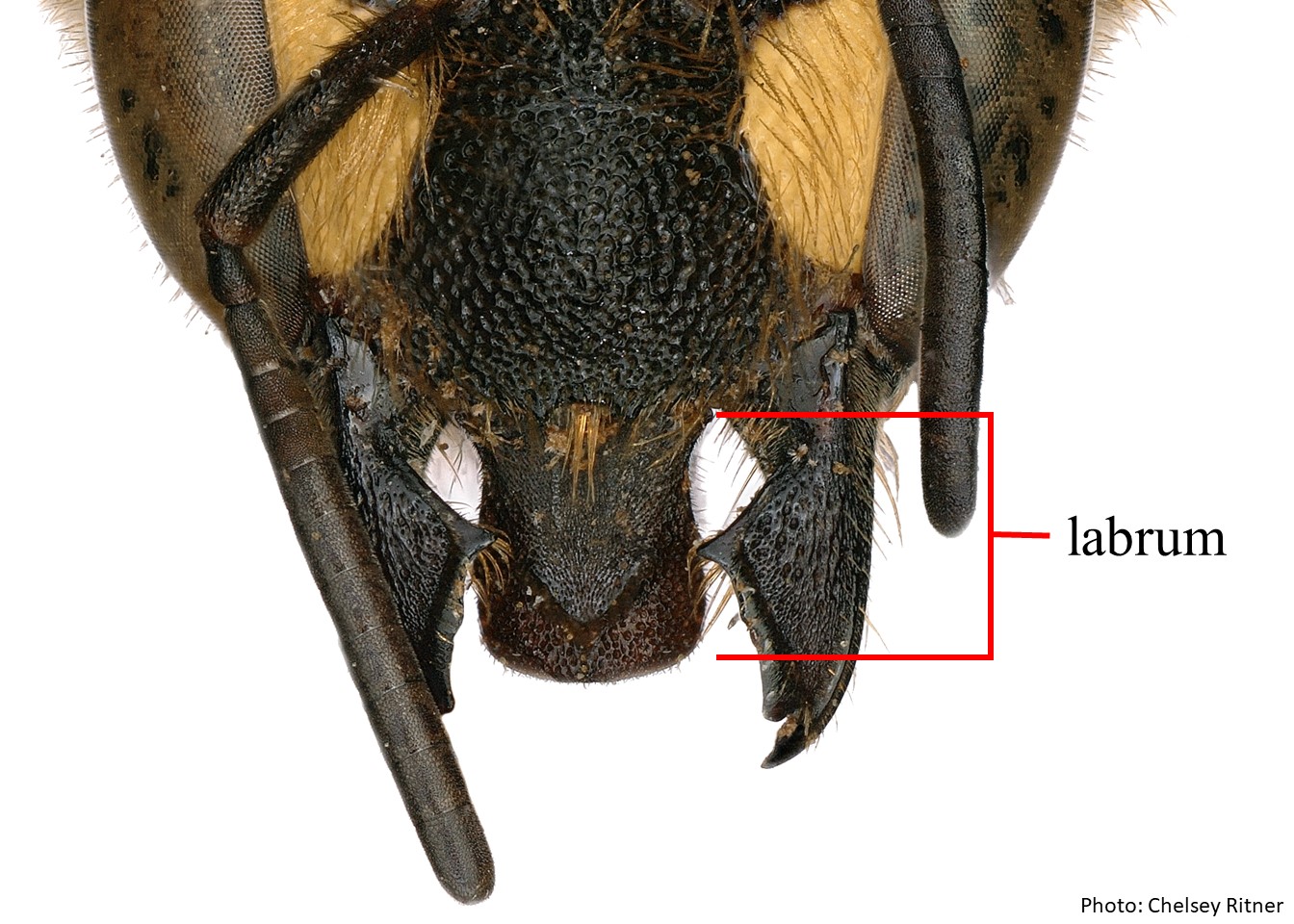Family: Megachilidae
Subfamily: Megachilinae
Tribe: Anthidiini
Genus: Anthidium Fabricius, 1804
Subgenus: A. (Anthidium) Fabricius, 1804
Species: Anthidium atripes Cresson, 1879
Common name: none
Anthidium (Anthidium) atripes have black integumentintegument:
a tough, protective outer layer
with cream or yellow-colored maculations (Gonzalez and Griswold 2013Gonzalez and Griswold 2013:
Gonzalez, V.H. and T.L. Griswold. 2013. Wool carder bees of the genus Anthidium in the Western Hemisphere (Hymenoptera: Megachilidae): diversity, host plant associations, phylogeny, and biogeography. Zoological Journal 168: 221ndash;425.). Females have black pubescencepubescence:
short, fine hair
on their legs and white hairs on the fronsfrons:
the area between the antennae and ocelli on the bee's head, vertexvertex:
the area between the ocelli and the back of the head, pronotal lobepronotal lobe:
a part of the pronotum located dorsally on the posterior margin of the pronotum and overlaps the anterior thoracic spiracle, scutumscutum:
the large segment on top of the thorax located between the wings and behind the head
, scutellumscutellum:
shield shaped plate behind scutum, axillaaxilla:
the triangular or rounded point on the thorax where thoracic muscles meet the forewing of an insect, and side of T1T1:
the segments on the top side of the abdomen, often abbreviated when referring to a specific segment to T1, T2, T3, T4, T5, T6, or T7 and T2T2:
and T2T2:
the segments on the top side of the abdomen, often abbreviated when referring to a specific segment to T1, T2, T3, T4, T5, T6, or T7 . Females range in body length from 7.7–11.5 mm (Gonzalez and Griswold 2013Gonzalez and Griswold 2013:
. Females range in body length from 7.7–11.5 mm (Gonzalez and Griswold 2013Gonzalez and Griswold 2013:
Gonzalez, V.H. and T.L. Griswold. 2013. Wool carder bees of the genus Anthidium in the Western Hemisphere (Hymenoptera: Megachilidae): diversity, host plant associations, phylogeny, and biogeography. Zoological Journal 168: 221ndash;425.). Males have black pubescencepubescence:
short, fine hair
on their genagena:
the cheek or side of the head and legs, and white hairs on their head and thorax. Males range in body length from 10.8–14.5 mm (Gonzalez and Griswold 2013Gonzalez and Griswold 2013:
and legs, and white hairs on their head and thorax. Males range in body length from 10.8–14.5 mm (Gonzalez and Griswold 2013Gonzalez and Griswold 2013:
Gonzalez, V.H. and T.L. Griswold. 2013. Wool carder bees of the genus Anthidium in the Western Hemisphere (Hymenoptera: Megachilidae): diversity, host plant associations, phylogeny, and biogeography. Zoological Journal 168: 221ndash;425.). Originally A. atripes was classified as a variety of Anthidium emarginatum (Schwarz 1928Schwarz 1928:
Schwarz, H.F. 1928. Bees of the subfamily Anthidiinae, including some new species and varieties, and some new locality records. Journal of the New York Entomological Society 36: 369ndash;419.).
(modified from Gonzalez and Griswold 2013Gonzalez and Griswold 2013:
Gonzalez, V.H. and T.L. Griswold. 2013. Wool carder bees of the genus Anthidium in the Western Hemisphere (Hymenoptera: Megachilidae): diversity, host plant associations, phylogeny, and biogeography. Zoological Journal 168: 221ndash;425.)
 with two preapicalpreapical:
with two preapicalpreapical: and T6T6:
and T6T6: lack maculations.
lack maculations. with distaldistal:
with distaldistal: has a broad, black brush with a concave margin.
has a broad, black brush with a concave margin. apexapex:
apexapex: bifidbifid:
bifidbifid: laterallateral:
laterallateral:Anthidium atripes may be confused with A. atripoides based on similar lengths, the depressed marginal zone of T3T3:
the segments on the top side of the abdomen, often abbreviated when referring to a specific segment to T1, T2, T3, T4, T5, T6, or T7 to T5T5:
to T5T5:
the segments on the top side of the abdomen, often abbreviated when referring to a specific segment to T1, T2, T3, T4, T5, T6, or T7 with sparse punctationpunctation:
with sparse punctationpunctation:
overall pattern of the punctures on a surface of a bee, includes size of punctures and the distance between them
, and a lack of smooth, shiny distaldistal:
place on a segment that is furthest from the place of attachment with the body
margins (Gonzalez and Griswold 2013Gonzalez and Griswold 2013:
Gonzalez, V.H. and T.L. Griswold. 2013. Wool carder bees of the genus Anthidium in the Western Hemisphere (Hymenoptera: Megachilidae): diversity, host plant associations, phylogeny, and biogeography. Zoological Journal 168: 221ndash;425.). Female A. atripes can be differentiated from A. atripoides by the presence of dense, long tomentumtomentum:
a form of pubescence composed of short matted, woolly hair
on the mid and fore basitarsusbasitarsus:
the segment of the tarsus that is the nearest to the body of the bee, usually the largest of all the tarsal segments and the thin apicalapical:
near or at the apex or end of any structure
margin of the clypeusclypeus:
a section of the face below the antennae, demarcated by the epistomal sutures in A. atripes (Gonzalez and Griswold 2013Gonzalez and Griswold 2013:
Gonzalez, V.H. and T.L. Griswold. 2013. Wool carder bees of the genus Anthidium in the Western Hemisphere (Hymenoptera: Megachilidae): diversity, host plant associations, phylogeny, and biogeography. Zoological Journal 168: 221ndash;425.). Male A. atripes can be differentiated from A. atripoides by the presence of a broad laterallateral:
relating, pertaining, or attached to the side
lobe on T7T7:
the segments on the top side of the abdomen, often abbreviated when referring to a specific segment to T1, T2, T3, T4, T5, T6, or T7 , a concave brush on the distaldistal:
, a concave brush on the distaldistal:
place on a segment that is furthest from the place of attachment with the body
margin of S4S4:
the plates on the underside of the abdomen, often abbreviated when referring to a specific segment to S1, S2, S3, S4, S5, S6, S7, or S8
 , and an incised apexapex:
, and an incised apexapex:
end of any structure
on the median lobe of S6S6:
the plates on the underside of the abdomen, often abbreviated when referring to a specific segment to S1, S2, S3, S4, S5, S6, S7, or S8
 in A. atripes (Gonzalez and Griswold 2013Gonzalez and Griswold 2013:
in A. atripes (Gonzalez and Griswold 2013Gonzalez and Griswold 2013:
Gonzalez, V.H. and T.L. Griswold. 2013. Wool carder bees of the genus Anthidium in the Western Hemisphere (Hymenoptera: Megachilidae): diversity, host plant associations, phylogeny, and biogeography. Zoological Journal 168: 221ndash;425.).
Anthidium atripes adults have been recorded in flight from May to July; however, a single record was documented on three separate occasions in late August, mid-September, and early November. Peak activity occurs from the last half of May to early July (Gonzalez and Griswold 2013Gonzalez and Griswold 2013:
Gonzalez, V.H. and T.L. Griswold. 2013. Wool carder bees of the genus Anthidium in the Western Hemisphere (Hymenoptera: Megachilidae): diversity, host plant associations, phylogeny, and biogeography. Zoological Journal 168: 221ndash;425.).
Anthidium atripes is a generalist that has been observed visiting a variety of species of Asteraceae, Boraginaceae, Brassicaceae, Fabaceae, Malvaceae, Plantaginaceae, and Polemoniaceae (Gonzalez and Griswold 2013Gonzalez and Griswold 2013:
Gonzalez, V.H. and T.L. Griswold. 2013. Wool carder bees of the genus Anthidium in the Western Hemisphere (Hymenoptera: Megachilidae): diversity, host plant associations, phylogeny, and biogeography. Zoological Journal 168: 221ndash;425.).
Nesting behavior is unknown.
Anthidium atripes occur throughout the western U.S., from southern California along the northeastern side of the Sierra Nevada Mountains, to eastern Oregon, southern Idaho, western Colorado, and west Texas (Gonzalez and Griswold 2013Gonzalez and Griswold 2013:
Gonzalez, V.H. and T.L. Griswold. 2013. Wool carder bees of the genus Anthidium in the Western Hemisphere (Hymenoptera: Megachilidae): diversity, host plant associations, phylogeny, and biogeography. Zoological Journal 168: 221ndash;425.). They are absent in Arizona and New Mexico. Anthidium atripes also occurs in Baja California, Mexico (Gonzalez and Griswold 2013Gonzalez and Griswold 2013:
Gonzalez, V.H. and T.L. Griswold. 2013. Wool carder bees of the genus Anthidium in the Western Hemisphere (Hymenoptera: Megachilidae): diversity, host plant associations, phylogeny, and biogeography. Zoological Journal 168: 221ndash;425.). They are primarily found between 1,100–3,200 m in elevation within the Rocky Mountains, and are absent in desert and forest ecosystems (Gonzalez and Griswold 2013Gonzalez and Griswold 2013:
Gonzalez, V.H. and T.L. Griswold. 2013. Wool carder bees of the genus Anthidium in the Western Hemisphere (Hymenoptera: Megachilidae): diversity, host plant associations, phylogeny, and biogeography. Zoological Journal 168: 221ndash;425.).
Distribution map generated by Discover Life -- click on map for details, credits, and terms of use.
Gonzalez, V.H. and T.L. Griswold. 2013. Wool carder bees of the genus Anthidium in the Western Hemisphere (Hymenoptera: Megachilidae): diversity, host plant associations, phylogeny, and biogeography. Zoological Journal of the Linnean Society 168: 221-425.
Schwarz, H.F. 1928. Bees of the subfamily Anthidiinae, including some new species and varieties and some new locality records. Journal of the New York Entomological Society 36: 369-418.